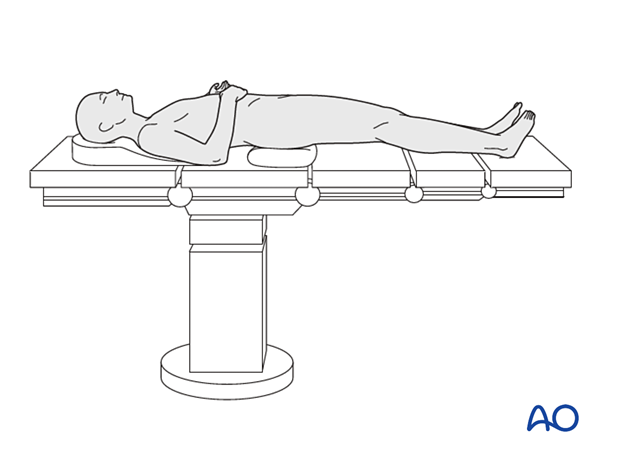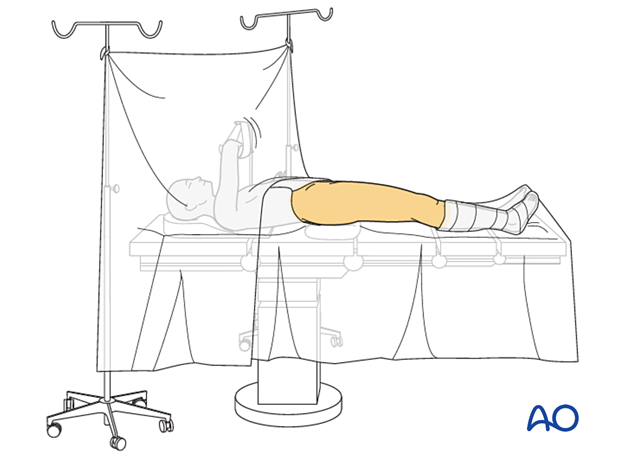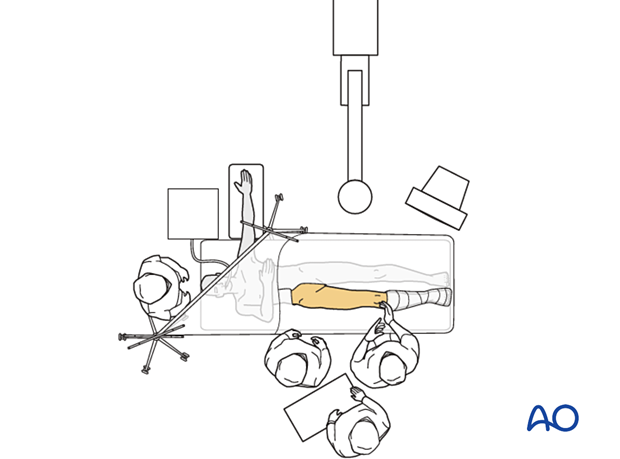Supine position
1. Introduction
This positioning is recommended for antegrade nailing and bilateral fractures because it can allow for the reduction and fixation of both fractures without requiring re-draping. However, the axial view may be difficult to obtain because elevation of the contralateral leg is required.

2. Preoperative preparation
Operating room personnel (ORP) need to know and confirm:
- Site and side of the fracture
- Type of operation planned
- Ensure that the operative site has been marked by the surgeon
- Condition of the soft tissues (fracture: open or closed)
- Implant to be used
- Patient positioning
- Details of the patient (including a signed consent form and appropriate antibiotic and thromboprophylaxis)
- Comorbidities, including allergies
3. Anesthesia
This procedure is performed with the patient under general or regional anesthesia
Long-lasting postoperative complete pain blocks for the patient with injured leg should be avoided as this could hide symptoms of a subsequent compartment syndrome.
4. Positioning
- Reconfigure the table or transfer the patient to a fracture table.
- Reduce the fracture with manual traction and manipulation to ensure reduction is possible before preparing and draping the patient.
- Pad all pressure points carefully (especially in the elderly).
- Position the image intensifier on the opposite side of the injury and the operating surgeon
- Ensure that you can get good-quality AP and lateral x-ray views of the entry point (piriform fossa), fracture site, and distal femur before draping.
- In obese patients it may be technically easier to perform antegrade femoral nailing in a lateral position without skeletal traction. Place the patient lateral (or supine with a large sandbag under the ipsilateral buttock) on a radiolucent table.
- Adduct and slightly flex the affected leg anteriorly in front of the unaffected one to ensure the position is reasonable for obtaining X-rays.
- A firm cushion placed in the midline beneath the pelvis may be used to elevate the pelvis from the table edge and facilitate the skin incision.
- The ipsilateral arm should not be positioned on an arm board or abducted, since it would interfere with nail insertion. An adducted (pictured) or elevated position is favored.
- The surgeon must be satisfied with the position before the patient is prepared for surgery.

5. Skin disinfecting and draping
- Maintain light manual traction on the limb during preparation to avoid excessive deformity at the fracture site.
- Disinfect the exposed area from above the iliac crest to the mid-tibia with the appropriate antiseptic.
- Free drape the affected limb(s) with a single-use U-drape. A stockinette covers the lower leg and is fixed with a tape. The leg is draped to be freely moved.
- Drape the image intensifier

6. Operating room set-up
- The surgeon, assistant, and ORP stand on the side of the injury.
- Place the image intensifier on the opposite side of the injury or surgeon.
- Place the image intensifier display screen in full view of the surgical team and the radiographer














